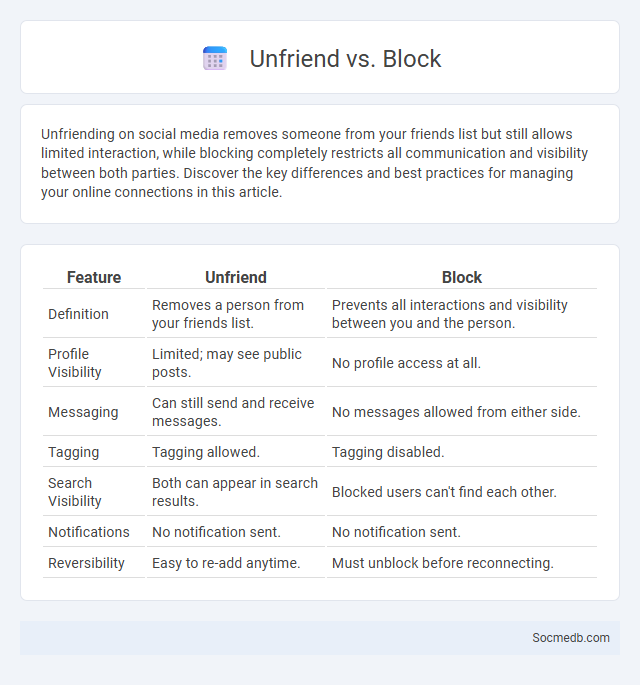
Photo illustration: Unfriend vs Block
Unfriending on social media removes someone from your friends list but still allows limited interaction, while blocking completely restricts all communication and visibility between both parties. Discover the key differences and best practices for managing your online connections in this article.
Table of Comparison
| Feature | Unfriend | Block |
|---|---|---|
| Definition | Removes a person from your friends list. | Prevents all interactions and visibility between you and the person. |
| Profile Visibility | Limited; may see public posts. | No profile access at all. |
| Messaging | Can still send and receive messages. | No messages allowed from either side. |
| Tagging | Tagging allowed. | Tagging disabled. |
| Search Visibility | Both can appear in search results. | Blocked users can't find each other. |
| Notifications | No notification sent. | No notification sent. |
| Reversibility | Easy to re-add anytime. | Must unblock before reconnecting. |
Understanding Unfriend, Block, and Unfriending
Understanding unfriend, block, and unfriending on social media is essential for managing your online relationships and digital privacy. Unfriending removes a connection from your friends list, limiting shared content visibility, while blocking prevents any interaction, including messages and profile viewing. Recognizing these features enables you to maintain control over your social media experience and protect your personal space effectively.
Key Differences Between Unfriend and Block
Unfriending on social media removes someone from your friends or followers list, allowing them to still view your public posts and send messages depending on your privacy settings. Blocking completely restricts the person from viewing your profile, sending messages, or interacting with your content in any form. Platforms like Facebook and Instagram use these features differently, with blocking offering a higher level of privacy and control compared to unfriending.
What Does Unfriending Really Mean?
Unfriending on social media means removing someone from your list of connections, which restricts their access to your personal updates and content. This action signals a decision to distance yourself from that person without necessarily blocking or ignoring them entirely. Understanding what unfriending entails helps you manage your online relationships and maintain control over your digital privacy.
When Should You Unfriend Someone?
You should consider unfriending someone on social media when their content consistently impacts your mental well-being or contradicts your values. Unfriending helps maintain a positive online environment tailored to your interests and emotional health. Regularly reviewing your friend list ensures your social media experience supports your overall happiness.
The Impact of Blocking on Social Media
Blocking on social media significantly alters user interactions by preventing unwanted communication and reducing exposure to harmful content, thereby enhancing digital safety and mental well-being. Studies show that users who actively block accounts experience lower levels of online harassment and increased control over their social media environment. This feature empowers individuals to curate their online experience, fostering healthier and more positive digital communities.
Pros and Cons: Unfriend vs Block
Unfriending on social media removes a person from your friends list, reducing interaction but still allowing them to view your public posts and send messages. Blocking goes further by completely cutting off access, preventing the blocked user from seeing your profile, posts, and contacting you in any way. While unfriending is less confrontational and maintains some level of visibility, blocking offers stronger privacy control and protection from harassment or unwanted contact.
Privacy Implications of Unfriending and Blocking
Unfriending and blocking on social media impact user privacy by controlling who can access personal information, posts, and interactions. These features help prevent unwanted contact and reduce exposure to online harassment or data misuse by restricting third-party access. However, the act of unfriending or blocking itself may signal social rifts and lead to indirect privacy breaches through mutual connections.
How to Decide: Unfriend or Block?
When deciding whether to unfriend or block someone on social media, consider the level of interaction and potential impact on your online experience. Unfriending removes the person from your friends list, limiting content visibility without notifying them, while blocking prevents any interaction, including messaging and profile viewing. Prioritize blocking for harassment or safety concerns, and unfriend when you simply want to reduce content clutter from acquaintances.
Social Etiquette: Handling Unfriending and Blocking
Social etiquette on social media involves respectful handling of unfriending and blocking to maintain digital harmony and prevent conflicts. Unfriending should be used thoughtfully to manage personal boundaries without causing offense, while blocking serves as a necessary tool to protect oneself from harassment or toxic interactions. Clear communication and discretion in these actions uphold a positive online environment and promote mutual respect among users.
Common Myths About Unfriending and Blocking
Unfriending and blocking on social media are often misunderstood actions rooted in common myths that can affect your online experience. Many believe unfriending always signals a personal conflict, but it frequently serves to curate your feed and protect your mental health rather than cause offense. Blocking is another myth-laden tool, wrongly seen as extreme or confrontational, when it primarily functions to prevent harassment and maintain your digital boundaries.
 socmedb.com
socmedb.com